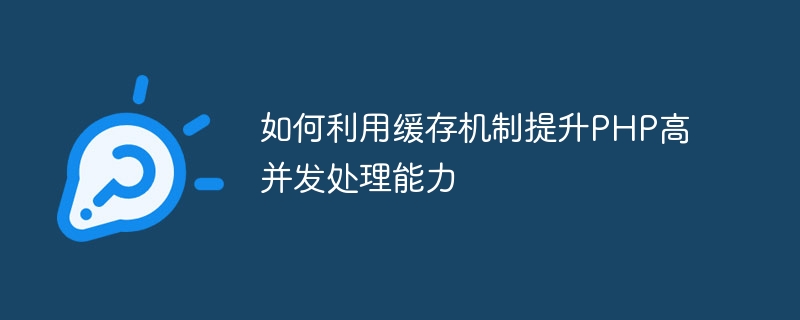

How to use the caching mechanism to improve PHP’s high concurrent processing capabilities
With the development of the Internet, the number of website visits increases, users’ concurrent access and data processing requirements increase. , the requirements for website performance are also getting higher and higher. As a widely used programming language, PHP has some difficulties in high concurrency processing. In order to solve this problem, we can use the caching mechanism to improve PHP's high concurrency processing capabilities.
Caching is a technology that stores data in high-speed storage devices so that it can be quickly retrieved and retrieved on subsequent accesses. By utilizing the caching mechanism, frequent access to the database can be reduced and the data reading speed can be improved, thereby improving PHP's high concurrency processing capabilities.
In PHP, commonly used caching mechanisms include file caching, memory caching, database caching, etc. The following will introduce how to use these caching mechanisms and provide corresponding code examples.
1. File caching
File caching stores data in files and reads data directly from the files when reading. The following is a sample code for a simple file cache:
function getFromCache($key) {
$cacheFile = 'cache/' . md5($key);
if (file_exists($cacheFile) && time() - filemtime($cacheFile) < 3600) {
return file_get_contents($cacheFile);
}
return false;
}
function saveToCache($key, $data) {
$cacheFile = 'cache/' . md5($key);
file_put_contents($cacheFile, $data);
}In the above code, the getFromCache function is used to get data from the cache. First, get the cache file name by calculating the storage path. Next, determine whether the cache file exists and whether it has expired. If the cache file exists and has not expired, the cached data is returned directly. Otherwise, return false. The saveToCache function is used to save data to the cache. First, get the cache file name by calculating the storage path. Then, use the file_put_contents function to write the data to the file.
2. Memory Cache
Memory cache stores data in memory and reads data directly from memory when reading. The following is a sample code for a simple memory cache:
$cache = [];
function getFromCache($key) {
global $cache;
if (isset($cache[$key])) {
return $cache[$key];
}
return false;
}
function saveToCache($key, $data) {
global $cache;
$cache[$key] = $data;
}In the above code, the $cache variable is an array used to store data. The getFromCache function is used to get data from the cache. First, determine whether the specified key exists in the $cache array. If present, the corresponding value is returned. Otherwise, return false. The saveToCache function is used to save data to the cache. Just store the data in the $cache array.
3. Database cache
Database cache stores data in the database and reads the data directly from the database when reading. The following is a sample code for a simple database cache:
function getFromCache($key) {
$db = new PDO('mysql:host=localhost;dbname=test', 'username', 'password');
$stmt = $db->prepare('SELECT data FROM cache WHERE key = :key');
$stmt->bindParam(':key', $key);
$stmt->execute();
$result = $stmt->fetch(PDO::FETCH_ASSOC);
if ($result) {
return $result['data'];
}
return false;
}
function saveToCache($key, $data) {
$db = new PDO('mysql:host=localhost;dbname=test', 'username', 'password');
$stmt = $db->prepare('REPLACE INTO cache (key, data) VALUES (:key, :data)');
$stmt->bindParam(':key', $key);
$stmt->bindParam(':data', $data);
$stmt->execute();
}In the above code, the getFromCache function is used to get data from the cache. First, connect to the database via PDO. Then, prepare the SQL statement and bind the parameters. Next, execute the SQL statement and obtain the results. If the result exists, the corresponding data is returned. Otherwise, return false. The saveToCache function is used to save data to the cache. First, connect to the database via PDO. Then, prepare the SQL statement and bind the parameters. Finally, execute the SQL statement to save the data to the database.
By utilizing caching mechanisms such as file caching, memory caching and database caching, PHP's high concurrent processing capabilities can be effectively improved, reducing frequent access to the database and improving data reading speed. In specific applications, you can choose a suitable caching mechanism according to actual needs, and optimize the code according to specific circumstances to further improve performance.
Reference materials:
The above is the detailed content of How to use caching mechanism to improve PHP's high concurrency processing capabilities. For more information, please follow other related articles on the PHP Chinese website!